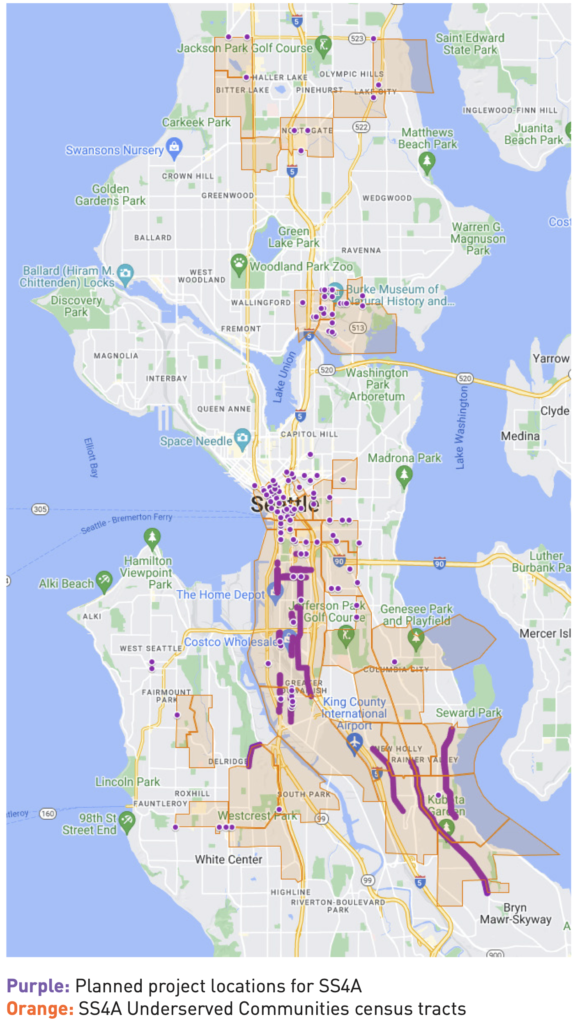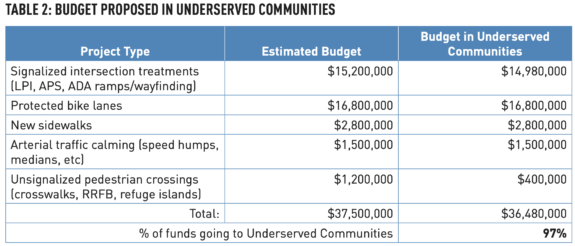
Seattle will receive a $25,654,000 grant from the USDOT’s Safe Streets for All program, Senator Maria Cantwell announced. Under the city’s $30 million proposal (PDF), the bulk of the funds would have focused on SoDo and Rainier Valley with spot improvements mostly focused in and near downtown, First Hill, Capitol Hill and the U District.
Ryan Packer reported on the Seattle proposal for the Urbanist in October. Their request was for the maximum amount under the grant program and “would be supplemented by a $7.5 million local match,” Packer reported.
In total, the city proposed 111 signalized intersection treatments, 6 unsignalized intersection treatments, 4 miles of protected bike lanes (part of the Georgetown to Downtown bike route), 1.5 miles of new sidewalks and 4.5 miles of arterial traffic calming. Here is the proposed budget breakdown if granted the full $30 million:
 Now Seattle will need to decide whether to cut $4.3 million worth of projects in the proposal that do not have funding commitments or if the city will increase their match to compensate and build the whole proposal.
Now Seattle will need to decide whether to cut $4.3 million worth of projects in the proposal that do not have funding commitments or if the city will increase their match to compensate and build the whole proposal.
Senator Cantwell was instrumental both in creating the Safe Streets for All grant program and getting it funded through the Infrastructure Investment and Jobs Act. Below is the full press release from Senator Cantwell’s Office:
Today, U.S. Senator Maria Cantwell (D-WA), Chair of the Senate Committee on Commerce, Science and Transportation, announced that the City of Seattle will receive a $25,654,000 federal grant to make the streets of SODO safer for pedestrians and bicyclists.
The grant comes from the Department of Transportation’s Safe Streets for All grant program. Sen. Cantwell created the program, steered its authorization of the program through the Commerce Committee, and ensured that the program was among the transportation investments included in the Bipartisan Infrastructure Law. Safe Streets For All grants help local governments carry out Vision Zero plans and other improvements to reduce crashes and fatalities, including for cyclists and pedestrians.
“Fatalities on our roads are increasing at a historic rate,” said Senator Cantwell. “This Safe Streets for All award for Seattle will help improve 117 intersections where 60 percent of the fatal and serious pedestrian collisions occur, create 1.4 miles of new sidewalks, and four miles of protected bike lanes.”
The city plans to improve the most intersections in southeast SODO where the highest number of serious pedestrian and bicycle accidents occur. The grant will fund the following projects:
- Four miles of protected bike lanes
- 1.5 miles of new sidewalks
- 4.5 miles of arterial calming treatments (such treatments can include speed bumps, horizontal shifts, and roadway narrowing)
- 117 intersection treatments (such treatments can include new signage, new pavement markings, and removal of clutter)
Bruce Harrell, Mayor of Seattle, said: “President Biden, Secretary Buttigieg, Senator Cantwell, and our federal delegation share our One Seattle commitment to ensuring every person — no matter how they get around — deserves to be safe. This ‘Safe Streets’ grant means we will accelerate efforts to improve and innovate our sidewalks and streets, especially in underserved and disproportionately impacted communities. From calming traffic on high-crash streets to helping families safely walk and bike to school, we must do everything we can to reverse the heartbreaking trend of people being injured on our streets. We’re grateful for this partnership and the significant resources that will go toward keeping people safe.”
Additionally, King County is among 16 communities statewide that will receive Safe Streets for All grants to fund the creation of comprehensive safety action plans. More information and list of recipients of those grants is available HERE.
Thanks to Sen. Cantwell’s leadership, the Bipartisan Infrastructure Law will deliver an estimated $7.6 billion in transportation investments to Washington state. In the first year since the law’s signing in November 2021, it funded nearly 500 transportation projects in the State of Washington.








Comments
5 responses to “Sen. Cantwell: Seattle wins $25.7M grant for safe streets, mostly in SoDo”
This is fantastic news! With funding secured, will work on the projects start this year? Or does this now kick off more detailed design planning? SODO and SE Seattle could desperately use this and more people are dying and getting hurt all the time.
I’m especially excited about improvements to Seward Park Ave S. between Morgan and Rainier. This will protect a key bicycle route (Lake Washington Loop Trail), part of the STP route, and arguably the most unsafe part of my bike commute towards downtown.
So in theory this is how we finally get a Downtown-Georgetown bike route, aside from the little details: that there isn’t really a good connection from downtown to the SODO Trail, and that ending at Lucille only gets you nominally into Georgetown. I could be wrong but I don’t think the Georgetown-South Park project extends all the way through Georgetown to the bridge, so we’ll have a gap right at the key place, through the middle of Georgetown.
It’s pretty disappointing that after all these plans and projects we’ll still be building routes that aren’t connected!
I agree. Neighborhood advocates have done an amazing job getting these two big pieces moving, but now it makes sense for the city to step up and say, “Let’s combine these two and make sure the whole thing is fully connected to the regional bike network.” I’d include the connection to the Green River Trail here, too.
Stuff like the Green River Trail and other regional connections is why I got so … Joker-fied I guess … by Jay Inslee posing on a bike for the release of a Leafline “vision” map with more gaps than connections. If anyone is positioned to take the regional view, to embody the wider vision and to call on cities to step up to it…
The SODO Trail is also, and we can’t forget this, a weak link. Even if we overcome all the usual obstacles (and a few unique ones) to connect the north end to downtown, both its north and south ends are awkward to get to. Then once you’re on the SODO Trail… is there nighttime visibility? Are there eyes on the street? Is there access to destinations (there are so many destinations in SODO — you wouldn’t know it from the trail)? If there’s something you need to avoid is there space to do so or opportunities to turn off (this can be a problem on other MUPs but few are as thoroughly fenced-in)? It’s not all bad … it’s safe from driveway crossings and has good access to Link and the SODO Busway. But some of its problems would be hard to solve even if the city cared to.
I heard we received the grant, but didn’t hear any details on what that might be. Thank you for sharing!! I was hit by an SUV while cycling which resulted in five months in the hospital, and now have disabilities. I was selected by “Families for Safe Streets” to speak and lobby at the National Bike Summit in DC at the end of this month. I will now contact Senator Cantwell and try to schedule a meeting.